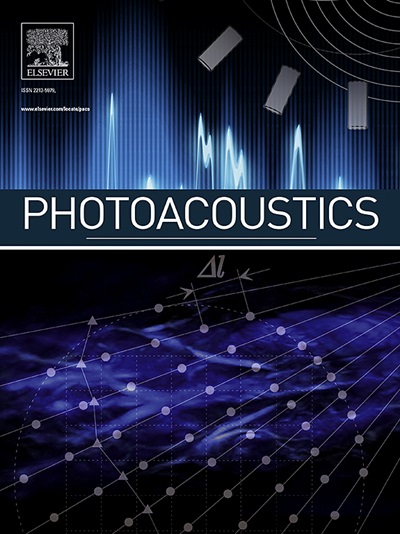Multiscale optoacoustic assessment of skin microvascular reactivity in carotid artery disease
IF 7.1
1区 医学
Q1 ENGINEERING, BIOMEDICAL
引用次数: 0
Abstract
Microvascular endothelial dysfunction may provide insights into systemic diseases, such as carotid artery disease. Raster-scan optoacoustic mesoscopy (RSOM) can produce images of skin microvasculature during endothelial dysfunction challenges via numerous microvascular features. Herein, RSOM was employed to image the microvasculature of 26 subjects (13 patients with single carotid artery disease, 13 healthy participants) to assess the dynamics of 18 microvascular features at three scales of detail, i.e., the micro- (<100 μm), meso- (≈100–1000 μm) and macroscale (<1000 μm), during post-occlusive reactive hyperemia challenges. The proposed analysis identified a subgroup of 9 features as the most relevant to carotid artery disease because they achieved the most efficient classification (AUC of 0.93) between the two groups in the first minute of hyperemia (sensitivity/specificity: 0.92/0.85). This approach provides a non-invasive solution to microvasculature quantification in carotid artery disease, a main form of cardiovascular disease, and further highlights the possible link between systemic disease and microvascular dysfunction.
颈动脉疾病皮肤微血管反应的多尺度光声评估
微血管内皮功能障碍可帮助人们了解颈动脉疾病等全身性疾病。光栅扫描光声介孔镜(RSOM)可通过众多微血管特征生成内皮功能障碍挑战期间的皮肤微血管图像。本文采用 RSOM 对 26 名受试者(13 名单一颈动脉疾病患者和 13 名健康受试者)的微血管进行成像,以评估在闭塞后反应性充血挑战过程中 18 个微血管特征在三个细节尺度上的动态变化,即微观(<100 μm)、中观(≈100-1000 μm)和宏观(<1000 μm)尺度。所提议的分析确定了与颈动脉疾病最相关的 9 个特征子组,因为它们在充血第一分钟的两组之间实现了最有效的分类(AUC 为 0.93)(灵敏度/特异度:0.92/0.85)。这种方法为心血管疾病的主要形式--颈动脉疾病的微血管量化提供了一种无创解决方案,并进一步强调了全身性疾病与微血管功能障碍之间可能存在的联系。
本文章由计算机程序翻译,如有差异,请以英文原文为准。
求助全文
约1分钟内获得全文
求助全文
来源期刊

Photoacoustics
Physics and Astronomy-Atomic and Molecular Physics, and Optics
CiteScore
11.40
自引率
16.50%
发文量
96
审稿时长
53 days
期刊介绍:
The open access Photoacoustics journal (PACS) aims to publish original research and review contributions in the field of photoacoustics-optoacoustics-thermoacoustics. This field utilizes acoustical and ultrasonic phenomena excited by electromagnetic radiation for the detection, visualization, and characterization of various materials and biological tissues, including living organisms.
Recent advancements in laser technologies, ultrasound detection approaches, inverse theory, and fast reconstruction algorithms have greatly supported the rapid progress in this field. The unique contrast provided by molecular absorption in photoacoustic-optoacoustic-thermoacoustic methods has allowed for addressing unmet biological and medical needs such as pre-clinical research, clinical imaging of vasculature, tissue and disease physiology, drug efficacy, surgery guidance, and therapy monitoring.
Applications of this field encompass a wide range of medical imaging and sensing applications, including cancer, vascular diseases, brain neurophysiology, ophthalmology, and diabetes. Moreover, photoacoustics-optoacoustics-thermoacoustics is a multidisciplinary field, with contributions from chemistry and nanotechnology, where novel materials such as biodegradable nanoparticles, organic dyes, targeted agents, theranostic probes, and genetically expressed markers are being actively developed.
These advanced materials have significantly improved the signal-to-noise ratio and tissue contrast in photoacoustic methods.
 求助内容:
求助内容: 应助结果提醒方式:
应助结果提醒方式:


